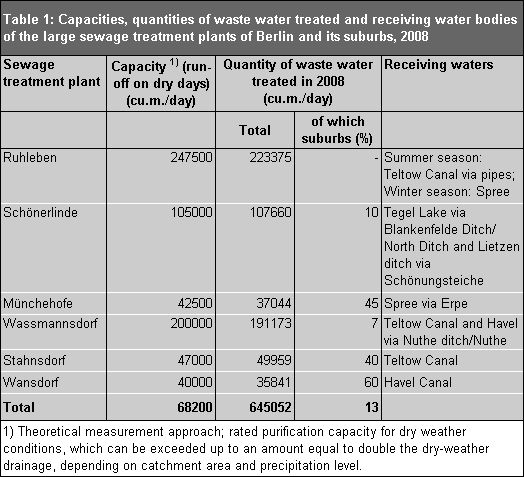In Berlin, precipitation and waste water from private households, public institutions, industry and trade, as well as run-off from public road areas generate large quantities of rain and waste water. These need to be piped away and treated, if appropriate. In 2008, the local sewage plants treated some 645,000 cu. m of waste water from private households, trade, industry and public institutions, as well as rainwater from Berlin and its suburban area every day. This quantity is equivalent to a little over 8 cu. m./sec., or one third of the Spree river run-off, given medium water flow. The amount of waste water generated in Berlin would be sufficient to fill the Grosser Wannsee lake within a week.
Waste waters are carried in a sewerage network with a total length of 9,360 km with 233,000 service lines. The sewerage network is operated by the Berliner Wasserbetriebe (Berlin Water Works). It was implemented in two different systems, the combined and the separate sewerage systems, and consists of a total of 4,178 km of waste water drains, 1,894 km of combined water drains, 3,166 km of rainwater drains and numerous special structures, such as rainwater overflows, rainwater retention basins and culverts. Waste water collected there is pumped to the sewage plants by 145 pumping stations, through a network of 1,120 km of pressurised sewage pipes.
Berlin’s combined sewage canal system was built In 1873 according to a design by James Hobrecht, to drain Berlin as it was then. However, towns and communities surrounding Berlin, which retained their independence until 1920, mainly built systems based on separate drainage. After their incorporation into Berlin, their facilities were amalgamated into the present system. Drainage areas are oriented towards river courses and shipping canals, and also in accordance with the different terrain heights. The boundaries of drainage areas do not follow the borders of Berlin’s boroughs. Some three quarters of Berlin’s drained areas are operated under the separate system, and the remaining quarter under the combined system.
The Separate System
In a system of separated drainage, waste water and rainwater are handled by two different systems. Waste water drains carry household, commercail and industrial waste water to the pumping stations. From there, pressurised pipes are used to take it to the Ruhleben, Münchehofe, Schönerlinde, Wassmannsdorf, Wansdorf, and Stahnsdorf sewage treatment plants. After treatment, sewage plants discharge purified water into Berlin’s bodies of water. Two other sewage treatment plants – at Marienfelde and Adlershof – were decommissioned as of 1990, and the Falkenberg facility was closed in 2003.

